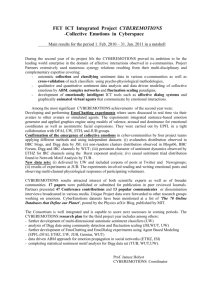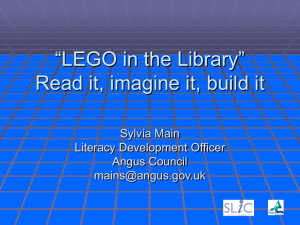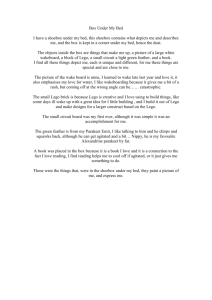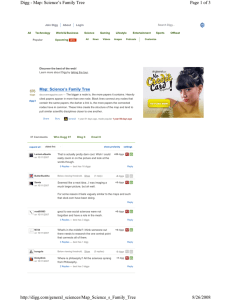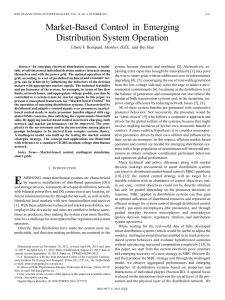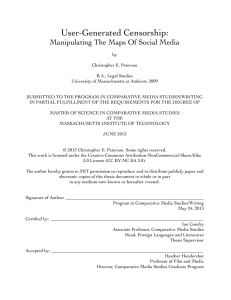The Prosumers
advertisement
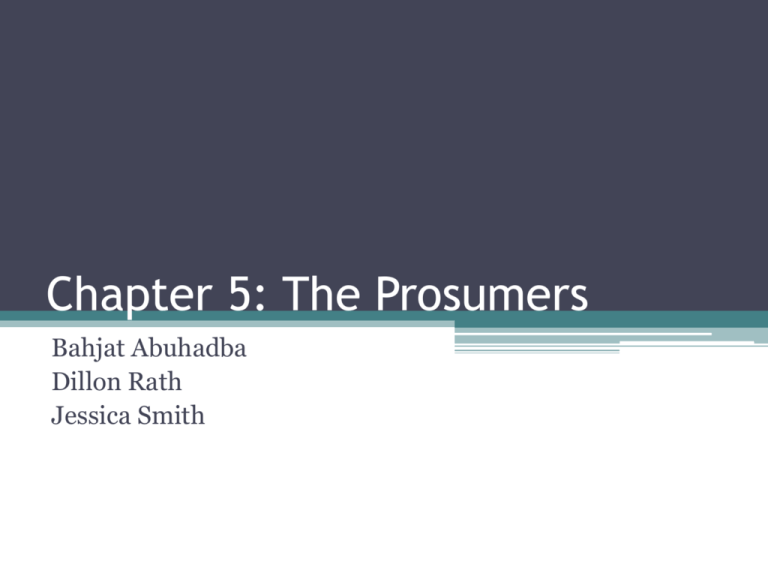
Chapter 5: The Prosumers Bahjat Abuhadba Dillon Rath Jessica Smith The Prosumers • Lawrence Lessig, Stanford Law Professor has been a strong advocate of law formation, “ They don’t get it, they think they’re stopping pirates when they are stopping all sorts of creativity”. Referring to politicians “19th century laws”. Law Formation - Lessig, has participated in the creation of the MMOG-Massively Multiplayer Online Gamealso known as Second Life in which over 325,000 participants socialize, entertain and collaborate on different topics. - Business Week referred to second life as - “The unholy offspring of the movie the matrix”. Second Life - Second life is created by it’s consumers who are at the same time producers, a consumer who helped develop the game can also be participating in it and making a living out of it, therefore, we can call such participants as “prosumers” The Prosumers - A Prosumer can be described as the customer or user of a product who participates in the creation of the products and good being used. - Prosumers in Second life have developed this virtual world greatly. As of July 2006 Second life was about the size of greater Boston and growing at a 15-20% per month. Second Life & Prosumers - There are few limitations in second life. Users can create just about everything from storefronts to bars, nightclubs, vehicles and other items for use in the game. In fact Linden labs, originator of second life, has less than a 1% contribution of contents. The rest is done by the users who contribute 23,000 of free development efforts everyday Second Life & Prosumers - Whatever users create in second life is theirs. So the efforts are not free. - For Linden labs, Second life giant, freewheeling customer economy that currently turns as estimated 100 million dollars a year. - Managers fear that second life is turning supposedly consumers into innovators. Customer as Co-innovators - The idea of consumers helping in the development of their products is not entirely new. The English have used it with mine openers to develop more effective equipment. - Nowadays, we see this phenomena being presented in modern ways such as the MTV show “Pimp My Ride”. Customer as Co-innovators goes SelfServe - David Pescovitz, senior editor of MAKE, magazine, a magazine that is devoted to do it yourself innovations states that the phenomena of DO IT YOUSELF has been spreading widely because innovators don’t have to wait for the next electronics meeting to express their ideas. With today’s technology it can be done anytime anywhere. Customer as Co-innovators goes SelfServe - The Lego Corporation, best known for making little interlocking plastic bricks has had a dramatic experience with prosumers. In fact, Lego had one of earliest and most vibrant prosumers communities that formed around it. - When the company started launching robotic toys in 1998, it noticed that not only Customer as Co-innovators goes SelfServe - Were the toys popular among teenagers, but also among adult hobbyists eager to improve them. - Lego threatened to file a lawsuit when many hobbyists sent letters of suggestions on how to enhance the products. - Lego’s policy backfired and users rebelled because they felt there ideas are not heard. Customer as Co-innovators goes SelfServe - However, Lego finally came around and went as far as developing a free version of software to get users contributions on improving their new products. - mindstorm.lego.com - The web site used by innovative-users to participate in Legos product developments. Success For Years To Come - It has become evident that today’s world is built on massive and collective collaboration in which groups of users and producers pull together to create the next big thing. - Lego has built success and innovation that will last for years to come because of its early awareness of the importance of its user’s ideas and their vibrant source of innovation in the long run. Control VS. Customer Hacking The process of prosumption • Customers get what they want • Companies get free R&D Apple’s iPod • The original use: portable music player • When customers hack it: portable music player, expanded memory, video games, PDA and Podzilla What this means to Apple • Threatening of viability of its current business model • Future product strategy • Less money spent in their stores Customer Hacking and Home-Brew Applications • Why hack: extend the capabilities of the media player • Home-Brewed apps are applications made by users and not the manufacturer • Example: Sony’s Playstation Portable (PSP) • The hacks: turned the PSP into a streaming music player, a WiFi device and a web browser Sony’s Response • They take extra steps to retroactively lock up their platform • How they do it: before you can play a game or you their software, you have to upgrade the PSP’s firmware (the OS that runs the PSP • What happens next: hackers crack the new firmware • Sony’s response: they don’t want customers to void the PSP’s warranty, so don’t hack….. Embracing Consumer Power • The Prosumption dilemma: A company that gives its customers free reign to hack, risks cannibalizing its business model and losing control of its platform • Hackers are a minority, but grow in number at a rapid pace • Customer hacking will never die and companies have no real control over it Listener-Artists and The Cambrian Explosion of Creativity • Most exciting and broadest frontier of user creativity • Contains amateur artwork, music, photos, stories and videos • Where it flows from: blogs, podcasts, wikis, internet television sites and peer-to-peer distribution channels What occurs now? • A rich, diverse outpouring of creativity • How it’s driven: by a convergence of peer-topeer networks, inexpensive digital devices, open source software, user-friendly editing tools, cheap storage and affordable bandwidths • Thus, resulting in “The Remix Culture” The Remix Culture • • • • Not a new term, but new applications Used in every day life, technology makes it easier Examples: music and videos Music: mixing and collaborating music and becoming bedroom DJ’s • Videos: has basically the same mindset • Can be a very lucrative business The Open Hand • Derived from the copyright laws • Which come from the grassroots movements • Creative Commons: An initiative launched in 02 that offers content creators flexible licenses • CC created a new platform called “ccmixter.org” where people can remix CC-licensed content and share it with the community • One of the only ways that remixing is allowed We are the Media We Are The Media • Rise of journalism and consumer-controlled media provide examples of how masscollaboration and cocreation are erasing the previous boundaries between companies and consumers. • A person can shift from consumer to contributor and creator YouTube • Began with a collection of home movies, independent films, and private video content • Now, it has over one hundred million plays a day and growing, it seems likely to be a force to reckon with. www.youtube.com Slashdot • Upload news items of interest to a global audience of techies and programmers. • Value is determined by the rating of readers and moderators on the site • Only editors can select user-submitted news items to display on the home page. • Visitors can’t see all the stories users submit. Nor can they vote on them www.slashdot.com Digg • Prodigal child of Slashdot • Simple and Democratic • User recommend interesting stories to one another by posting links to the Digg site. • Healthy competition to discover great stories makes Digg a vibrant source for timely tech news. www.digg.com www.digg.com/spy Digg • Why is this happening on Digg and not CNN or New York Times? ▫ Digg’s creators have learned how to make news a social pastime. Slashdot/Digg • Slashdot – known for quality and highly technical discussions • Digg – known for its immediacy and the sheer volume of aggregate stories • Both sites make most traditional news outlets look like archaic relics of a bygone era, especially when it comes to the way these sites interact with and relate to their audiences Media Concerns • They look at sites like Digg and worry that second-rate stories will make it onto the front page. • They are worried that journalist might start posting their stories directly and let the community decide which stories are newsworthy and important. • Digg and Slashdot aggregate, rate and comment on the news, they don’t do the hard-core reporting. Democratizing Media • If mainstream outlets engaged and cocreated with their audiences then the media experience would become more dynamic • Serious news organizations should also allow its community of readers to join in the editorial conversation. • The new Web challenges the assumption that information must move from credentialed producers to passive consumers. Democratizing Media • Democratization of media publishing tools, is rapidly transforming our notions of how expertise, relevance, and professionalism develop in the media. • Mainstream media is changing and media organizations must change too or they will be bypassed by a new generation of media-savvy prosumers who increasingly trust the insights of their peers over the authority of CNN or the Wall Street Journal. Harnessing Prosumer Communities • Prosumption is becoming one of the most powerful engines of change and innovation that the business world has ever seen. • Cocreating with customers allows companies to produce a better product or service. • But it comes with new rules of engagement and tough challenges to existing business models. Harnessing Prosumer Communities • More than customization ▫ Mass customization generally entails mixing and matching prespecified components, which significantly limits flexibility and innovation for users. Dell Computers (DVD players) • Losing Control ▫ Customer will use your product for their own innovations, without permission (iPod, PSP) ▫ If you don’t stay current with customers, they invent around you, creating opportunities for competitors. ▫ So it is important to sacrifice some control. Harnessing Prosumer Communities • Customer tool kits and context orchestration ▫ If customers are going to treat your product as a platform, make your products modular and reconfigurable. ▫ Make customer tool kits and supply raw materials so that customers can add value to your product ▫ You are designing for prosumption • Becoming a peer ▫ Real businesses are not creating finished products, but innovation ecosystems IBM (Linux – does not own or control) Second Life (99 % of value creation is by customers) Harnessing Prosumer Communities • Sharing the fruits ▫ Customers will expect to share in the ownership and fruits of their creations. eBay ( thousands of eBay's customers make there living there, while eBay takes a cut of their transactions) Second Life’s (customers create game content, but Second Life owns the IP rights) The Future of Prosumption • Company-Centric View ▫ We’ll set the parameters by telling you when and on which products to innovate. You’ll give us your ideas for free, but we’ll choose the best of them – and keep all of the rewards and IP. • New Prosumer-Centric View ▫ Customer’s want a genuine role in designing the products of the future The Future of Prosumption • If you expect to be around in the next decade, your organization will need to find ways to join and lead prosumer communities
